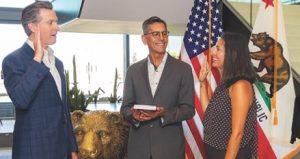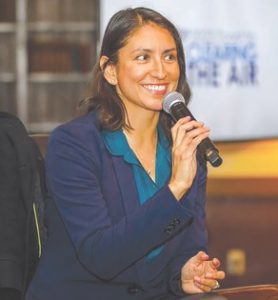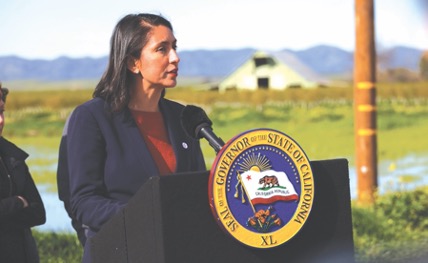When Yana Garcia was named Secretary of California’s Environmental Protection Agency in August, the state was in the midst of a historic drought. About nine months later, dry farmland and communities are flooded, reservoirs are nearly full and mountains of snow are starting to melt.
Needless to say, climate and water supply resiliency are top of mind for the newest CalEPA Secretary.
“What we’re seeing is that even our best models don’t quite accurately predict the weather whiplash that we’re experiencing,” said Garcia. “A climate-resilient California is one in which Californians can feel safe in the environment that surrounds them. That means that as we experience intensifying weather extremes, our state and its infrastructure are prepared to manage it so that droughts won’t mean a household is without water and our grid will be prepared for extreme heat, even while transitioning to a carbon neutral future. It also means inherently that neither race nor income should determine relative access to that sense of security and the ability to recover from increasingly frequent disasters.”

Yana Garcia was named CalEPA Secretary in August 2022. Above, she is sworn in by Gov. Gavin Newsom as her father Sergio Garcia holds the California Constitution and looks on. Garcia will lead state efforts to combat climate change, improve air and water quality, regulate toxic substances and more.
Photos courtesy of the State of California.
Garcia, who was appointed last year as the first Latina CalEPA Secretary by Gov. Gavin Newsom, oversees the state’s efforts to fight climate change, protect air and water quality, regulate pesticides and toxic substances, achieve the state’s recycling and waste reduction goals, and advance environmental justice.
“Yana’s deep connection to communities, her strong track record as an environmental attorney in holding polluters accountable, and her commitment to bringing diverse interests together make her uniquely matched to the challenges facing California,” said Gov. Newsom in announcing her appointment.
California’s water supply strategy, released the same month as Garcia’s appointment, aims to help California prepare for a possible 10 percent long-term reduction in our water supply by 2040. “That is still a goal worth achieving,” said Garcia. “We need to be prepared for a reduction in water supply, which means continuing to expand water reuse and maintaining our focus on conserving water.”
The state has also invested billions to enhance the state’s water resilience. The plan to modernize water infrastructure includes investments in storage, recycling, desalination, stormwater capture and conservation.
“Despite the heavy rain and snowpack we’re seeing now, we always have to be ready for drought, and we have to remain vigilant of water quality impacts caused by the prevalence of contaminants,” said Garcia. “The less water we have, the more potent the impact of those contaminants.”

As head of CalEPA, Garcia oversees the California Air Resources Board (CARB), the Department of Pesticide Regulation (DPR), the Department of Resources Recycling and Recovery (CalRecycle), the Department of Toxic Substances Control (DTSC), the Office of Environmental Health Hazard Assessment (OEHHA), and the State Water Resources Control Board (SWRCB). She recognizes the importance of partnering with each of these departments and following through on commitments promised with tangible and beneficial results.
“Ultimately, we have to increase access to critical resources,” she said. “We do that through comprehensive partnerships, not only with our government colleagues but also through effective partnerships with community-based organizations who really have the trust of so many hard-to-reach residents. It is also important that we retain transparency in our decision-making processes and that we deliver on our responsibility to protect and enhance the environment and the health of all Californians.”
Garcia, who served from 2021 to 2022 as Special Assistant Attorney General to California Attorney General Rob Bonta, is nationally known for her work to uplift the voices of those from disadvantaged communities. In her tenure as an Assistant and Deputy Secretary at CalEPA she led three Environmental Justice Task Force Initiatives in the communities of Pomona, Imperial County and Stockton. She also led the program that delivered more than $1 million in Environmental Justice Small Grants to 28 organizations to combat pollution, improve health outcomes and increase public engagement in some of California’s most pollution-burdened communities. That program has now grown to a multi-year $20 million investment program to increase capacity in some of the state’s most pollution-burdened areas.
“One of biggest lessons I learned early in my career is that all too often communities, particularly low-income communities and communities of color, are faced with this false choice between economic growth and stability, and access to clean, safe jobs and environmental quality,” she said. “Our communities deserve both. I tend to approach decisions by taking a big step back from the notion that economic growth should come at the cost of environmental quality and health, or vice versa.”
Garcia is proud of her accomplishments on the environmental justice front because she’s witnessed the movement grow in power and influence in such arenas as drinking water quality, pollution, and the oil and gas industry. Now, she is looking forward to crafting policy implementation strategies with a wide array of stakeholders.
“It’s so important to notice who is at the decision-making table, and who is absent. My experience has been focused on marginalized communities who have all too often been left out,” Garcia said. “But I’m equally committed to understanding where we may have a business perspective lacking or that of any group who may be impacted by an issue.”
In tackling the state’s water supply challenges, Garcia aims to strike a balance between interests to protect the environment, human health, and economic growth in the many regions of the state from rural to urban.
“I think municipal entities, water agencies, technology drivers, workforce developers, and more are necessary in developing the kind of water solutions that we’re going to need to deliver clean, safe, and affordable drinking water to all Californians,” she said. “We cannot and should not do this alone. To meet the goals of the human right to water and ensure the water supply that underpins our economy, we must put old paradigms behind us and all show up to bridge the gap between our water supply and demand to create a climate-resilient California.”
By Elizabeth Smilor
Special Sections Writer
